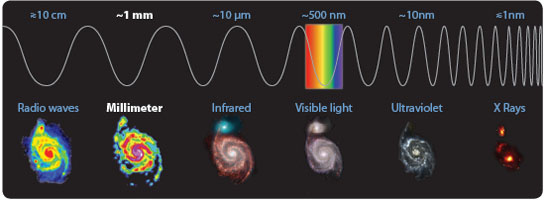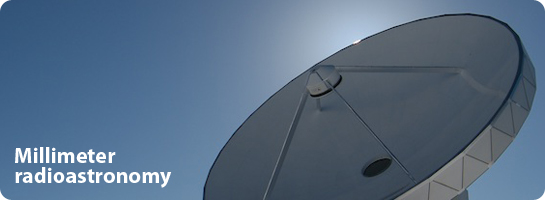Millimeter radio astronomy is a recent branch of astronomy. It was only in the 1960’s that the first receivers sensitive enough to detect the millimeter waves originating from space were built. Since then, this observing technique has become a key means of investigating the universe.
Radio astronomy in particular has been crucial in detecting numerous interstellar molecules. In addition to the detection of water in space, more than one hundred molecules, many unknown on earth, have so far been identified using millimeter astronomy. The millimeter radiation of molecules – which contrary to visible light is not absorbed by interstellar clouds of dust – has enabled astronomers to make numerous discoveries. Not only is it possible to study dense, dark clouds, previously uninvestigated – but also to explore cold matter, a few degrees above absolute zero, where stars are formed.
Molecules and dust are key elements in the evolution of the matter dispersed between stars: this so-called interstellar matter is continuously transformed in cycles, which are regulated by stellar birth and death. Molecules, which are most abundant in dense interstellar clouds, play a dominant role in gas cooling and therefore in the evolution of interstellar clouds that, by gradual collapse, can initiate the birth of one or many stars.
Any remaining surrounding matter orbits around the newborn star in the form of circumstellar disks. In these disks, the gas and dust continues to evolve in a more and more complex way, eventually forming protoplanets. Shells of matter that are ejected by a dying star add further molecules and freshly-made dust to the interstellar environment. When exposed to the strong radiation of a nearby star, the surface of interstellar clouds can become the site of numerous chemical processes involving the formation of complex molecular species.

The illustration above shows where IRAM telescopes operate in relation to other well known wavelengths, from radio waves to x-rays. The M51 galaxy is represented as it is observed at each frequency. By combining data from across the spectrum astronomers are constantly increasing their knowledge of distant cosmic objects.
The enrichment of interstellar matter is driven by these various processes. Starting with hydrogen, the most abundant atom in the universe (created in the Big Bang) and less abundant atoms such as carbon, nitrogen and oxygen (synthesized in the stellar interiors), these processes first form simple molecules such as carbon monoxide, methanol or ethanol; then more and more complex molecular species, including those at the origin of life.
The cosmic cycle of interstellar matter can best be studied using millimeter radioastronomy. The IRAM telescopes, equipped with cutting-edge technology, are ideally adapted to explore the cycle of molecules and dust in space.


